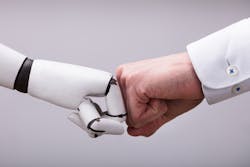How Practical AI is Already Making Your Job Easier
by John Hall
Over the past decade, artificial intelligence (AI) has grown into a source of great excitement. But for some, it’s an even greater source of anxiety as people worry how groundbreaking advancements in AI and machine learning could affect them and, more importantly, their work.
Flashy headlines might prompt employees in frontline construction jobs to believe that their livelihood is in danger, and a recent survey by The Workforce Institute at Kronos found that a third of employees worldwide view the rise of AI as synonymous with the replacement of their roles altogether. Yet much of what has been expected of AI has yet to actually occur.
The vast majority of technological advancements fueled by AI are replacing workflows rather than people. As research analysts like Gartner predict that AI will create more jobs than it eliminates this year, contract employees can more realistically expect to see AI have a positive impact on their workday through minor, practical changes.
On a daily or weekly basis, employees will perform a small set of tasks quite regularly — like clocking in for a shift, clocking out for lunch, requesting time off, swapping a shift with a co-worker, or submitting their timecard at the end of the week. We can all agree that these processes should be quick, efficient, and digital. What we call “practical AI” — intelligent technology that automates time-consuming administrative processes — is streamlining these tasks and allowing contract employees and their managers to have greater control over these important moments, the moments that truly matter to people as they strive to achieve a healthy work-life balance.
Here are three ways that practical AI is already making a meaningful difference today:
1. Requesting time-off
Nearly 3 in 10 employees feel frustrated with how long it takes a manager to approve their time-off requests, and nearly half (47%) say they have had a time-off request rejected by their employer within the previous 12 months.
Employers: Consider utilizing the practical capabilities of AI to make submitting a request for time off much easier for your employees. With just one click, scheduling engines can allow employees to take control of their work-life balance and skip the days (and sometimes weeks) of feeling uneasy while they await approval of their time-off request. Similarly, by utilizing AI, managers can take a step back from navigating the highly manual process of reviewing time-off requests and instead turn their focus to high-value initiatives, like employee development and customer service.
2. A custom-fit scheduling experience
Can your organization improve its scheduling practice? Nine in 10 employees think so; in fact, more than a quarter (28%) wish their employer would embrace self-scheduling. With the help of practical AI, modern workplace technology can drill down into an employee’s prior work schedules — including shifts worked, shifts swapped, and types of jobs they preferred doing — to quickly and easily analyze these historical insights and generate a personalized schedule that is custom-fit to meet the employee’s expectations.
By cross-comparing best-fit schedules with anticipated shift coverage and customer demand, intelligent scheduling ensures both business needs and employee needs are simultaneously met. Imagine an employee never having to work on a project that doesn’t maximize their skillset. With practical AI, that’s not just imagination — that’s reality.
3. Goodbye, frantic calls! Hello, advanced shift-swapping
Think back to the last time you may have needed to switch your shift or call out of work. Maybe your child got sick before school, or your car broke down on the way to work. With no guarantee that someone could cover the shift, the aimless texting, calling, and posting begins. And once you do find coverage, waiting for a manager to approve the shift swap can be just as stressful.
Technology has prompted an increasing expectation for instant gratification in the workplace: One-third (33%) of employees want scheduling solutions that make it easier to swap shifts, find coverage, and pick up additional shifts, ideally from a mobile device. This is where AI can play a valuable role: real-time shift-swapping. Thanks to historical data analysis, an intelligent workforce management system already knows who is scheduled, who is available, and whether a certain time aligns with another employee’s schedule preferences. Without managerial intervention, technology can make recommendations based on past shifts, as well as auto-approve schedule changes on the backend.
It is more important than ever that employers educate employees about the practicality of AI — particularly when the newest cohort of employees have grown up as the digital generation. But don’t forget, we are working alongside multiple generations and need to consider and respect numerous perspectives within the same workspace. Nearly 2 in 5 Baby Boomers working in the U.S. are either not sure how AI would improve their job or don’t think it’s possible.
It’s time that employers embrace the practical applications of AI as a way to ultimately free people from administrative burden and allow them to focus on their most important stakeholder — the client.
John Hall is director of the services and distribution practice group at Kronos Incorporated.
